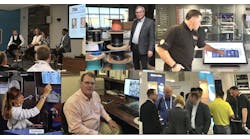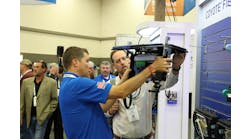Latest from Professional Development/Leadership
Bel Air Internet Evolution and Case Study
"We prided ourselves on offering old-fashioned neighborhood-style customer service and an excellent product. (And that guy who let me use his pine tree? He ended up being one of our first big investors and a good friend.)"
I knocked on the door and waited at the front stoop, a wireless antenna in my hand.
A few moments later, a tall, skinny man came to the door. "Can I help you?"
"I was wondering if you’d let me hang an antenna from that pine tree you have in your yard," I said, knowing full well how crazy I sounded to this total stranger.
But I was desperate. It was 2002 and I couldn’t get anything but slow dial-up Internet at my house. Adding salt to the wound, the cable company had been telling me high-speed Internet would be available in our neighborhood "next quarter". But they’d been saying that for 2 years.
Fed up, I linked up with a few other tech-minded neighbors and set out to find the highest point in our neighborhood to install an antenna. After spotting the 80-foot pine tree in a neighbor’s yard (and, yes, with
his permission), we created a base station to deliver high-speed Internet wirelessly to our homes.
Fast-forward almost 15 years, and that jerry-rigged pine tree has evolved into Bel Air Internet, the full-service communications company of which I serve as President. Today, we provide high-speed Internet, television, and voice service to over 50,000 customers across residential and commercial buildings throughout Southern
California and Las Vegas, using the most technologically advanced Internet delivery system in the region.
How did we get here? With one core guiding principle, and a few big decisions at some forks in the road, that ultimately helped us grow to where we are today. In fact, I can point to 3 specific fork-in-the-road moments that most impacted our journey.
The first occurred early in our company’s history. When we initially broadcast Internet wirelessly from
that tree, it was just supposed to be for our own mutual benefit. Instead, I found myself energized by this method of Internet delivery.
So, harkening back to my earliest days in Fuller Brush sales, I went door-to-door through our neighborhood and other enclaves along the Mulholland Corridor in Los Angeles, where I sold our wireless Internet service to enthusiastic customers who had also been shut out by the cable and phone companies.
There were 3 of us working 15 hours a day (from my home) to expand our customer base and our knowledge of wireless technology. We prided ourselves on offering old-fashioned neighborhood-style customer service
and an excellent product. (And that guy who let me use his pine tree? He ended up being one of our first big investors and a good friend.)
At the time, we were deploying Point-to-Multipoint technology, something no one else was doing.
Fork in the Road #1
Our fledgling business faced its first fork in the road when I learned the strengths and weaknesses of Point-to-Multipoint technology (PTMP). Though it was working well for us at the moment, the bottom line was that as more content began to stream online, PTMP wouldn’t be able to keep up with the speed due to inherent latency issues.
It was a huge revelation that could’ve stopped us in our tracks — but instead it led to my decision to shift the entire model of the company. No longer would our goal be to service neighborhoods — because that wouldn’t be sustainable for very long. Instead, we’d focus on Multiple Dwelling Units (MDUs) so we could employ wireless Point-to-Point technology (as opposed to PTMP), and increase speeds as time went on.
At that point, the big telecom companies had begun rolling out their Triple Play packages including television and phone. We knew we needed something similar to get in the door of any MDU. However, despite all the shifts we were making, we didn’t want to abandon our guiding principle: that excellence, both in product and neighborhood-style customer service, be maintained. Thus, we couldn’t just resell other vendors’ phone lines because there would be no way to manage the quality level.
Instead, we created our own VoIP software, launching a hybrid phone service with the cost advantages of VoIP and the benefits of an old-fashioned landline — like the ability to call 911. I also met with satellite television provider DirecTV, who granted us Authorized Dealer status. Even better, we could provide our own DirecTV infrastructure at buildings we serviced to ensure the quality remained superb.
Armed with our own Triple Play, I found myself going door-to-door again, this time to developers throughout Los Angeles. I got my first bite with The Toy Factory, a, pioneering loft development opening in the Arts District in downtown L.A. To differentiate ourselves from the cable and telephone companies also offering Internet in the building, we did everything the opposite of them: we answered our own phones; we gave residents set appointment times; we actually guaranteed our Internet speeds (instead of offering "up to" speed promises); and we delivered symmetrical upload and download speeds. We were the first ISP to do so from our inception in 2002.
Word quickly spread throughout the building, and our customer base grew. Other developers began calling us, and we sold our Internet, TV, and phone services to a myriad of new and existing developments across the
city. We expanded our footprint beyond Downtown Los Angeles, using the rooftops of the buildings to extend our network.
At the same time, we also expanded our scope of customers. Many of our residential customers owned their own companies and wanted to get their business Internet from us, too, so we branched out further, providing our services to commercial buildings and offices. In doing so, we pioneered "Volume Knob Internet" for businesses, a way for them to turn up or down their bandwidth in real time with a single call to us. This feature was invaluable to companies like post-production houses who would get slammed at certain times of the month delivering video files, but didn’t need as much bandwidth at other times. Because we operate on a digital network it was simple for us to do, and yet another way to differentiate ourselves.
Fork in the Road #2
It was at that point, with business growing quickly, that we reached our second notable fork in the road — a trap that could have ended our company altogether. The wireless industry coalition had just introduced WiMAX, a new set of wireless standards meant to fix the kinks previously plaguing PTMP networks. An array of new, inexpensive radio products were launched to facilitate these networks. Most other Wireless ISPs (WISPs) immediately hopped on the bandwagon, but, because of our previous research, we remained skeptical.
Despite the WiMAX changes, after looking further into the products, even calling the semi-conductor manufacturers ourselves, we remained unconvinced that PTMP would work. So, we stuck with our high-quality Point-to-Point delivery system. The other WISPS initially gained loads of customers with their new low prices, but their PTMP networks couldn’t provide the quality, speed, or reliability their consumers needed. They began hemorrhaging customers. Every single WISP in Southern California either went out of business or was sold for pennies on the dollar.
Meanwhile, Bel Air Internet sidestepped this potential pitfall by sticking to our quality principle — and our growth accelerated. We expanded our services to student housing developments and hotels, and stretched our footprint further to include Santa Clarita, Orange County, and Las Vegas.
Fork in the Road #3
Our third, most recent, fork in the road led to the creation of an entirely new division within our company. A few years ago, out of the blue, we received a request to provide temporary Internet for a beach interview Disney was filming with a young celebrity. It was the day before the shoot and the Internet connection they thought they had wasn’t going to work, and to rent a satellite truck would have been prohibitively expensive.
Initially, I didn’t want the job — it seemed like a lot of hassle for a one-day gig. We ended up doing it as a favor, but I said to our contact, "No more after this." However, the next week we got a call for another temporary Internet event.
Just as I had noticed an under-serviced group when providing high-speed Internet to those first neighborhoods around Mulholland, I realized there was a huge under-serviced market in the temporary Internet arena.
As conventions attracted thousands of guests who needed to access Wi-Fi on their devices, and events began live-streaming and adding social media-components, reliable, high-speed Internet was becoming a necessity. We created our Pop Up Internet division, which has now provided short-term broadband for events like the Oscars, Golden Globes, and Grammy red carpets, the Santa Monica Pier concert series, E3 events, the Star Wars convention, and the recent Yves Saint Laurent fashion show, among many others. It’s been so successful we spun it off into BAI LIVE, a new division of Bel Air Internet in which we provide Pop Up Internet, Managed Wi-Fi and Streaming services for events, conferences and conventions.
Learnings
Though that pine tree officially retired many, many years ago, we still stick to the core value that brought us here: quality and neighborhood-style customer service. We still answer our own phones, we still take the time
to do meet-and-greets at new buildings so we can get to know our customers face-to-face, and we still are always looking for that next fork in the road to evolve our company yet again.
[toggle title=”Koosed-isms” load=”hide”]Though we live in the high-tech and fast-moving ICT industry, we need to remember that people do business with people. There’s no M2M solution when it comes to doing business the right way. That’s why I’ve created some anecdotal guides to help our team create long-standing relationships with our customers.
Here are 5 truisms you should remember when the ICT machine is pushing you to your limits.
"No bad deal ever gets good."
Often salespeople and businesses, especially fledgling start-ups, are tempted to agree to a not-so-great deal in which they don’t make enough of a profit margin, hoping it will lead to better deals in the future (either from the same customer or in gaining new ones). I’ve never experienced one instance of this being true. The mythical "good deal" always remains in the distance like a desert oasis mirage, and chasing it with a bad deal is a good way to drive your business straight into the ground.
"Cheap is expensive."
Do you hire the top-of-the-line expert technician or the one with less experience whose salary is much less? Do you build out the network with top-shelf equipment or use the mid-level products? The bottom line looms large when making business decisions, but the bigger picture should always win out in the end. In our business, even a short service outage affects thousands of customers, and greatly exceeds the money we’d save cutting costs on tech labor. (And once you get a bad reputation, that’s often impossible to salvage.) The value of having something done properly the first time is ALWAYS less expensive.
"Persistence, persistence, persistence."
My sales team is sick of hearing this phrase, but I’ve found persistence to be the core truth in how to drive your company forward. When Bel Air Internet was trying to sell its services to that first MDU, we had the deck stacked against us. Specifically, we had no name recognition. We needed a building that was close to downtown Los Angeles where our home base station was, and we were delivering Internet wirelessly at a time when "wireless" was viewed as a bad word due to its connotation with the miserable cell phone service in Los Angeles. But we called hundreds of developers, doggedly pursuing them when they were definitely sick of hearing from us, until, finally, one took a chance on us. It opened the gateway for everyone else.
"Don’t outsource customer service."
Whenever you put a third party between you and your customers, you do yourself a disservice. Your customers are the most important part of your business. So, why would you disconnect from them or avoid them just to save a penny? I’ve found that answering your phones in-house is the best way to keep your finger on the pulse of what’s going on with your customers. We stay abreast of problems and create relationships with them in a way unachievable through reports generated by an outsourced company.
"Tell the worst first."
It’s hard to tell the stone-cold truth. In fact, it’s tempting to tell your potential clients only what they want to hear, and then wait until the bitter end when they’re very much on board; that is NOT the time to slip in those not-so-pleasant facts. The problem? Those little facts could be deal-breakers, and now you’ve wasted time pursuing a deal that was actually doomed from the start. Instead, I like to be candid early on about potential issues so no one is misled and no time is lost. If the potential customer is still on board, I can build from there to all the great services we have to offer. The objective is to end on the high note (and more often than not, that results with a sale).[/toggle]





